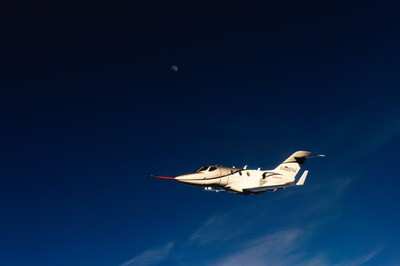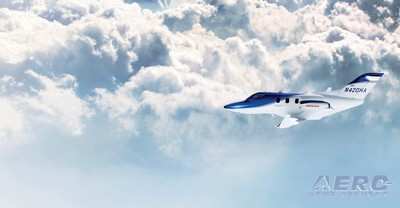Production Of The Aircraft Expected To Begin Next Year
Honda Aircraft Company announced Monday at EBACE that it
has successfully completed additional milestone flight tests with
its FAA-conforming HondaJet, including the achievement of a maximum
operating altitude of 43,000 ft. This accomplishment follows soon
after Honda's advanced light business jet recorded a maximum speed
of 425KTAS during flight testing at the company's Greensboro, NC,
world headquarters facility.

The 43,000 ft. mark - reached on April 27 - confirms the
company's maximum-operating-altitude performance commitment to
customers for the FAA-conforming HondaJet. In addition, the
aircraft has achieved a climb rate of 3,990 ft./min., confirming
another important performance parameter for the delivery
aircraft.
"We are very encouraged by the achievement of these important
performance milestones at this early phase of the HondaJet flight
test program," said Michimasa Fujino, Honda Aircraft Company
President & CEO. "Our flight test data indicate that the
aircraft is performing as expected, and our team continues to work
hard to realize additional performance milestones as we move
forward."

The first FAA-conforming HondaJet (F1), which first flew on
December 20, 2010, will soon be joined by additional conforming
aircraft to supplement the company's certification efforts. A
second conforming aircraft (ST1) already has been completed and
undergone extensive structural testing under various load
conditions to ensure conformity with all certification
requirements. Furthermore, Power-On testing has been completed
successfully on a third conforming aircraft (F2) that will be used
for flight testing. Honda is nearing completion of function testing
on this aircraft, which is scheduled to join the flight test
program this summer.
A fourth conforming aircraft (F3), to be used for additional
flight testing, has progressed through the major assemblies
consolidation phase and is now in the early stages of systems
installation. A fifth conforming aircraft (ST2) also is planned to
be completed in early 2012 to support additional stress and
extensive fatigue testing. Concurrent with the assembly of
conforming aircraft, Honda continues to conduct numerous component
qualification tests for each aircraft system to support the
certification program.

"In order to maximize the effectiveness of our flight test
program and to support an accelerated certification process, we
will add a sixth conforming aircraft (F4) to our certification
fleet," said Fujino. "This test aircraft will take flight in spring
2012 and will support cabin systems testing, as well as functions
and reliability testing. With a total of six aircraft planned to
support the certification process, we believe we will have optimal
resources to meet both our flight test program needs and our
certification schedule.
As Honda progresses through the certification program, the
company is focused simultaneously on the process of equipping and
manning its new HondaJet production facility, which was recently
completed on the company's Greensboro campus. Pre-production
planning and preparations are in progress as equipment and
personnel begin to move into the facility. Training of production
staff will soon be underway to support the HondaJet production
ramp-up beginning in 2012.

The 263,400 sq. ft. HondaJet production facility integrates
under one roof all aspects of assembly, painting, completion,
inspection and flight testing of delivery aircraft. This unique
approach to production will provide Honda with a distinct advantage
within the industry by allowing the company to create the highest
quality aircraft possible within a totally integrated assembly and
testing environment.
 ANN's Daily Aero-Term (04.24.24): Runway Lead-in Light System
ANN's Daily Aero-Term (04.24.24): Runway Lead-in Light System ANN's Daily Aero-Linx (04.24.24)
ANN's Daily Aero-Linx (04.24.24) Aero-FAQ: Dave Juwel's Aviation Marketing Stories -- ITBOA BNITBOB
Aero-FAQ: Dave Juwel's Aviation Marketing Stories -- ITBOA BNITBOB Classic Aero-TV: Best Seat in The House -- 'Inside' The AeroShell Aerobatic Team
Classic Aero-TV: Best Seat in The House -- 'Inside' The AeroShell Aerobatic Team Airborne Affordable Flyers 04.18.24: CarbonCub UL, Fisher, Affordable Flyer Expo
Airborne Affordable Flyers 04.18.24: CarbonCub UL, Fisher, Affordable Flyer Expo






